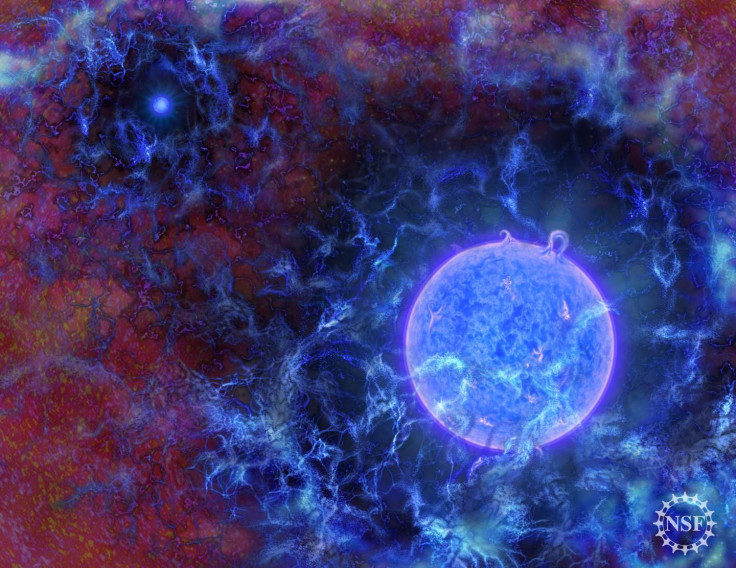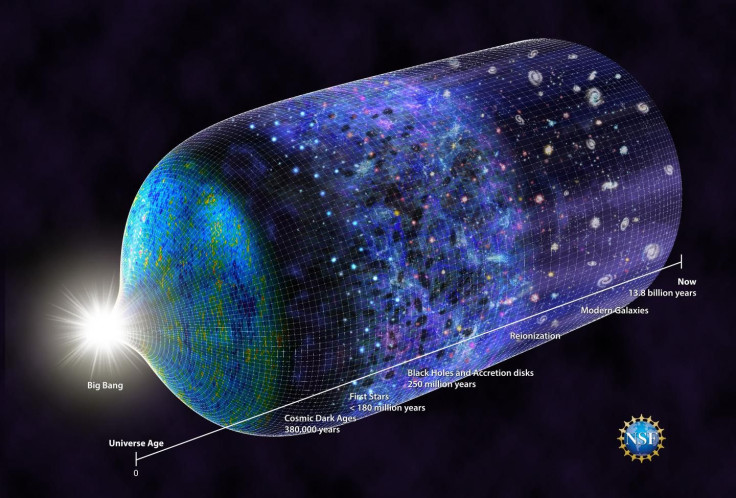Dark Matter Interactions, Earliest Stars In A Colder Than Expected Young Universe
Following the birth of the universe according to the Big Bang theory, there followed a long period of time when everything was still shrouded in darkness. Using radio wave signals, researchers have surmised that time, before first stars lit up the universe, to be about 180 million years.
Researchers from Arizona State University (ASU), Massachusetts Institute of Technology (MIT) and University of Colorado, Boulder, published a paper in the journal Nature explaining the discovery. The earliest stars in the universe were big and blue, and emitted a lot of ultraviolet light. Some of that UV radiation interacted with hydrogen, the simplest of all elements that permeated the early universe in the absence of other chemicals.
The hydrogen atoms that had been interacting with UV light began absorbing photons from the cosmic microwave background (CMB) — the background electromagnetic radiation that is spread throughout the universe right from the time it was born. That would cause dips in the intensity of CMB radio signals, and it was those dips the researchers were looking for. The frequency of the dipping radio waves can be used to approximate when the event causing the dip took place.
“This is the first real signal that stars are starting to form, and starting to affect the medium around them. What’s happening in this period is that some of the radiation from the very first stars is starting to allow hydrogen to be seen. It’s causing hydrogen to start absorbing the background radiation, so you start seeing it in silhouette, at particular radio frequencies. … We see this dip most strongly at about 78 megahertz, and that frequency corresponds to roughly 180 million years after the Big Bang. In terms of a direct detection of a signal from the hydrogen gas itself, this has got to be the earliest,” study co-author Alan Rogers from MIT said in a statement Wednesday.

The signal was detected as a part of Experiment to Detect the Global EoR (Epoch of Reionization) Signature (EDGES) project, which is funded by the National Science Foundation. The study used a refrigerator-sized radio spectrometer located at the Murchison Radio-astronomy Observatory (MRO) in Western Australia.
“It is unlikely that we’ll be able to see any earlier into the history of stars in our lifetimes. This project shows that a promising new technique can work and has paved the way for decades of new astrophysical discoveries. … Now that we know this signal exists, we need to rapidly bring online new radio telescopes that will be able to mine the signal much more deeply,” Judd Bowman from ASU, who was lead author of the paper, said in another statement.
The study also revealed the universe in its infancy was about twice as cold as previously thought. The universe likely had a temperature of about 3 kelvin (270 degrees Celsius or 454 degrees Fahrenheit, below zero) at that time 13.5 billion years ago.

To explain that temperature anomaly, scientists needed to come up with new theories. One of them is by Rennan Barkana of Tel Aviv University in Israel, who said it could be the “first direct proof that dark matter exists.”
The mysterious dark matter cannot be directly observed using our current technology, even though it is thought to account for 85 percent of all the mass in the observable universe. Its presence is inferred through its gravitational effect on other objects, and the search for it is one of the holy grails of physics.
Referring to the signal detected by the EDGES project, Barkana said in a statement: “I realized that this surprising signal indicates the presence of two actors: the first stars, and dark matter. The first stars in the universe turned on the radio signal, while the dark matter collided with the ordinary matter and cooled it down. Extra-cold material naturally explains the strong radio signal. … This insight alone has the potential to reorient the search for dark matter.”
The researchers behind the detection of the signal published their Nature paper under the title “An absorption profile centred at 78 megahertz in the sky-averaged spectrum” and it appeared online Wednesday. Barkana published a separate paper about his theory in the same journal, under the title “Possible interaction between baryons and dark-matter particles revealed by the first stars” that also appeared online Wednesday.
© Copyright IBTimes 2025. All rights reserved.



















